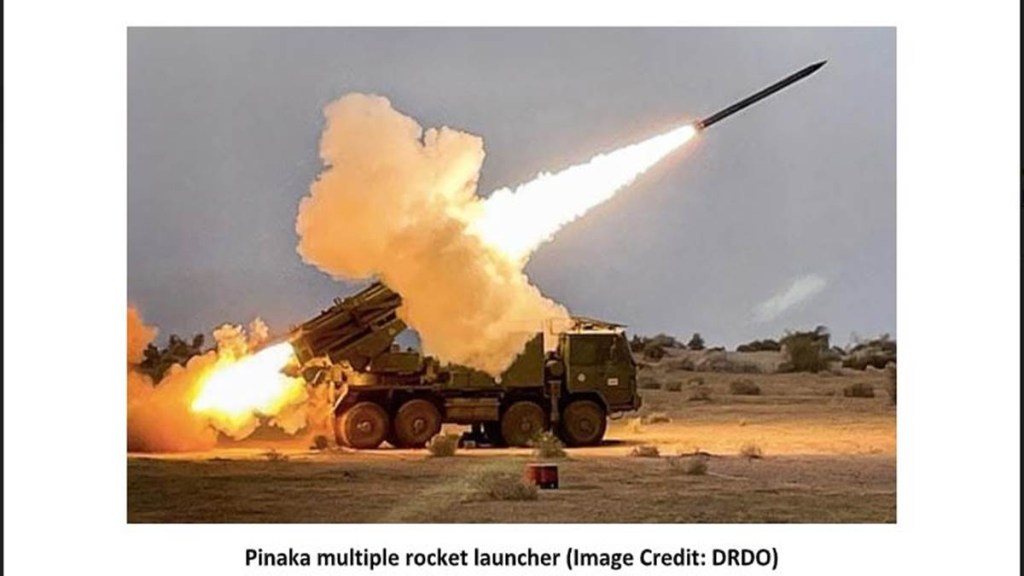By Debajit Sarkar
At the macro level, every single conflict is about the attrition of the opponents’ field forces, war-making capability, and/or will to fight. In order to attain a position of advantage created by way of attrition; one must be able to impact the enemy without incurring greater losses, frequently by using weapons with greater stand-off ranges to protect friendly forces.
The Indian Army’s conventional infantry forces will have to fight against enemy forces in a linear fashion. Therefore, they are subject to topography and the consequences that weather, geographical and man-made obstacles, and canalization have on the landscape. Due to their inherent closeness to hostile forces, infantry forces are also exposed to attrition by unrelenting indirect fire from cannons, rockets, mortars, and missiles that are designed to utilize stand- off ranges to their advantage. For these reasons, infantry forces care more about these indirect fire dangers than they do about an adversary's war-making capability.
This is where rocket artillery comes in. Rocket artillery does not exactly assist the fighting directly. Rocket artillery is Army/Corps/Division resources that are deployed far from the frontlines for counter-battery duties. i.e., when an enemy artillery fires, the blue force artillery radar will track the trajectory of the artillery round and ascertain the approximate location of the enemy artillery. The friendly rocket artillery will then be delivered to the location and they will fire their rockets to overwhelm the area. In contemporary warfare troops and hardware never assembled in one place near the frontline. Artillery, armoured vehicles and infantry, air defence, are positioned at a distance from each other.
The Indian Army has a long history of using rocket artillery. The Indian Army had the 62xBM-30 Smerch systems and the BM-21 Grad launchers. Both these MLRS systems are of Russian origin. While the Grad lacks the range in terms of anti armour guided weapons it does have the ability to deliver much more top attack munitions per load than Smerch, but launches them over shorter range.
To replace the BM-21 Grad India’s Defence Research and Development Organization (DRDO) toiled hard to develop the indigenous Pinaka Multi Barrel rocket launcher (MBRL) based on an 8×8 vehicle. Pinaka is a comprehensive system that integrates high energy propulsion, submunition warheads, servo- controlled launcher structure as well as fire control computer. Pinaka Incorporate State-of-the-art technologies for providing superior combat performance. Pinaka proved its combat capabilities during the Kargil conflict in June 1999.
Each Pinaka battery is composed of six launcher vehicles, six loader- cum replenishment vehicles and two command post vehicles. Every launcher vehicle carries two pods that accommodate a total of 12 rockets. Each Pinaka rocket can carry a 100 kg payload for a range of 40 km. A solitaryPinaka battery can neutralize a surface area of 700m x 500m. Upcoming rockets of the Pinaka system will have a much greater range.
A salient aspect of the Pinaka MBRL is that it continues to evolve and can therefore be upgraded to fire a variety of new rockets. Some of the new rockets that DRDO should consider developing are:
(1) A new 200km range rocket for the Pinaka that can hit in one salvo a cluster of targets at a major distance from each other, as they concurrently launch projectiles separate in flight, each corresponding to its input GPS-based target data. The upgraded Pinaka system should be able to automatically obtain and process information from drones or reconnaissance vehicles; it does not need to be keyed by the operator. With a 200km range this rocket can effectively carry out Suppression of Enemy Air Defenses(SEAD) operations because several ground-based radars are in that range.
(2) Taking a leaf out of the SA-6 SAM complex that employs a rocket booster as a combustion chamber for a ramjet, the DRDO can develop a ramjet powered rocket. A ramjet can be 3D printed quite quickly. This ramjet powered rocket could fly for a couple of minutes at low power settings that just remove drag and let it cruise along for huge distances, or it could run for a shorter phase with a higher thrust setting, permitting it to climb and move relatively fast at higher altitudes.
(3) Rocket tube launched drone. Having a rocket tube launched drone means the Indian Army will not have to depend on a separate recon unit to locate targets or support their operations. Much of the time the Indian Army’s artillery force will work along with recon and intel forces which probably will have their own drones that will search for and find appropriate targets for the rocket artillery battery and then after a first rocket attack the drone can observe the results and calculate if another attack is needed or not.
Also Read: Emergency Procurements: Panacea or detrimental to capability development?
Pinaka MBRL will be extremely effective in any border conflict against China or Pakistan in targeting armoured formations. The adversary’s armoured vehicles can button up and drive through rocket artillery fire but as soon as they button up, their ability to see diminishes to a large extent. And as they drive through the artillery fire, there is a high chance they will have firepower and mobility damage or that the formation will alter its direction of attack. The results are interruption and suppression of armour. By far, perhaps the most important factor is production of these rockets. Over the years the production of Pinaka rockets has increased. With two active defence corridors in Uttar Pradesh and Tamil Nadu and an increase in the participation of the Indian private sector in the defence industry there is every reason to believe that the volume of production will increase going forward.
The author is a subject matter expert on competitive intelligence and market research in the defence & aerospace industry.
Disclaimer: Views expressed are personal and do not reflect the official position or policy of Financial Express Online. Reproducing this content in any form without permission is prohibited.
